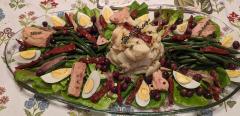 We have new neighbors, a fine friendly couple named Mike & Maryann. We invited them over for a Provencal Feast on Sunday, December 17th, 2023. I selected Provencal food because it's different from what we usually see in Plymouth, it's popular with many people, and it was a chance to bring a splash of sunny southern France into our gray December day.
We have new neighbors, a fine friendly couple named Mike & Maryann. We invited them over for a Provencal Feast on Sunday, December 17th, 2023. I selected Provencal food because it's different from what we usually see in Plymouth, it's popular with many people, and it was a chance to bring a splash of sunny southern France into our gray December day.
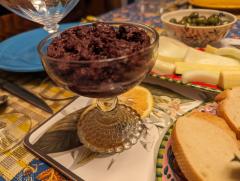 We normally start with an Aperitif in the Living Room, but the Christmas tree made that room too crowded so everything was in the dining room. For the aperitif, we opened with Absinthe cocktails and chilled Lillet Blanc, and:
We normally start with an Aperitif in the Living Room, but the Christmas tree made that room too crowded so everything was in the dining room. For the aperitif, we opened with Absinthe cocktails and chilled Lillet Blanc, and:
- Black Olive and Fig Tapenade, salty-sweet
- The Count’s Anchoiade, a wonderful anchovy-based spread with 13 ingredients! These two recipes are from Sarah Leah Chase's delightful Pedaling Through Provence.
- Marinated olives, because olives are inescapable in Provence
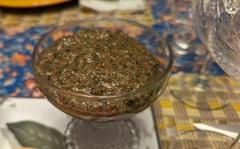 Croute and bread rounds, crudites
Croute and bread rounds, crudites - Ratatouille served cold (Ratatouille can be served either hot or cold, for comparison it is served hot in the Releve course after the fish.)
Note that there was no cheese in the opener. A traditional French dinner serves cheeses after the meat course. This is because the alkaline nature of cheese is thought to balance the acidity caused in the stomach by the preceding meat and other dishes.
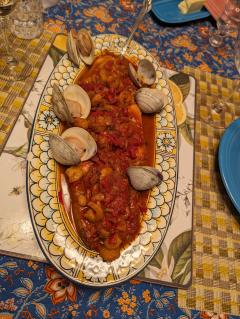
The Soupe course was Aigo Bouido with croutons au fromage, accompanied by a cool Cote de Provence Rose. Alas! I failed to get a photo from this dinner so I will just have to make it again. Fortunately, it's no hardship, either making it or eating it!
For the Poisson (fish) course, I made a Swordfish Provencal, thick steaks of fresh swordfish briefly marinated and seared, then served in a savory tomato-based sauce made with garlic, oregano, thyme, and dry vermouth. We continued with the Cote de Provence Rose.
Then we had a Releve course between the fish and the meat: this was the same Ratatouille that we had cold in the Aperitif course, this time served hot for comparison. We opened up a Cotes du Rhone to accompany it. The Cotes du Rhone red wine also set us up for the bigger red wine in the next course.
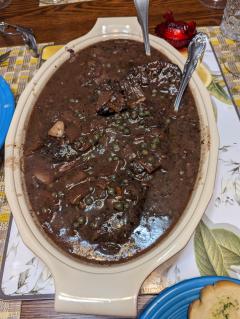 We were slowing down by the time we got to the Viande (meat) course, and the conversation was flowing easily. For this course I brought out a hot Provencal Daube along with a delicious Reserve des Diacres 2011 Chateauneuf-du-Pape from the cellar.
We were slowing down by the time we got to the Viande (meat) course, and the conversation was flowing easily. For this course I brought out a hot Provencal Daube along with a delicious Reserve des Diacres 2011 Chateauneuf-du-Pape from the cellar.
A daube is a form of French stew that requires long slow cooking. This one simmered for six hours: the meat was exquisitely tender and flavorful. After marinating overnight and then cooking for hours in red wine with balsamic vinegar, orange zest, garlic, and onions, the sauce gets thickened up and flavored with capers and mashed anchovies dissolved in olive oil. It's a knockout dish, also from Pedaling Through Provence.
Centuries of courtly cuisine have taught the French a thing or two about the order of courses for an hours-long feast. In a French formal dinner, the Salade course comes next, to lighten things up. The Salade course was a fine Salade Nicoise, a beautiful composed salad containing olives, anchovies, tuna, hard-boiled eggs, and other delights on a bed of butter lettuce dressed with a fresh-made vinaigrette. You can see the Salade Nicoise in the photo at the top of the page.
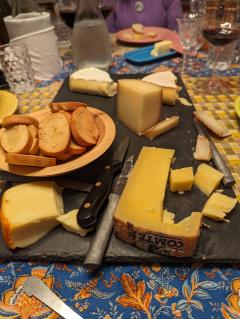 We finally reached the Fromage course. I cannot say that I felt particularly acidulated at that time. Perhaps I have built up a tolerance for such alimentary insults over years of big feasts, or maybe the French have more delicate constitutions; I have observed that the average Frenchman of my age is more than somewhat slimmer than my august self!
We finally reached the Fromage course. I cannot say that I felt particularly acidulated at that time. Perhaps I have built up a tolerance for such alimentary insults over years of big feasts, or maybe the French have more delicate constitutions; I have observed that the average Frenchman of my age is more than somewhat slimmer than my august self!
So I set out selection of popular French cheeses on the slate:
- Istara P’tit Basque (standing, in the middle)
- Saint Nectaire (back right)
- Brie (back left)
- Port Salut (front left)
- Comte (front right)
These led to lively discussion and comparison, with the diners selecting favorites and describing what they liked about them. We also managed to find the bottoms of those three bottles of wine somewhere during this leisurely course.
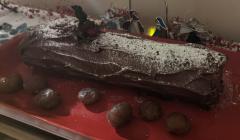 At last we reached the Dessert course. It being very near Christmastime, the main attraction was a very fine (although not particularly Provencal) Buche de Noel accompanied by Marrons Glace. This is my mother's recipe, a genoise butter cake filled with hazelnut buttercream and iced with a chocolate-cream cheese frosting.
At last we reached the Dessert course. It being very near Christmastime, the main attraction was a very fine (although not particularly Provencal) Buche de Noel accompanied by Marrons Glace. This is my mother's recipe, a genoise butter cake filled with hazelnut buttercream and iced with a chocolate-cream cheese frosting.
We were out of wine by this point, so I served some Pierre Ferrand Cognac to finish the French dinner.
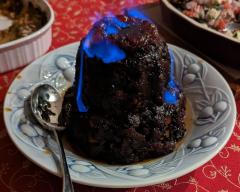
Not to gild the lily, but I also put out a steaming hot Christmas Pudding, baptized with cognac and flamed, served with hard sauce.
There's really no place for this traditional English mainstay of the holiday season, but a few weeks earlier Mike had helped me to make the puddings for the holidays and this was a chance for him to sample the fruit of our labors.
Most of the recipes for this feast came from Mastering the Art of French Cooking by Simone Beck, Louisette Bertholle, and Julia Child, and from Pedaling Through Provence by Sarah Leah Chase.
